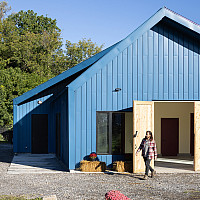The school has a Formech 450 vacuum former. Watch a video of a Formech 450 in action. The machine is available for use by Architecture students at no cost; however, students must supply their own approved materials (see below).
USAGE REQUIREMENTS
- Before using the vacuum former, it is required that one receives training and authorization from Fabrication Lab staff technician John Bryant in Room 008. It is important to read all of the following protocols. Failure to comply with them may result in a fire, broken machine, wasted time and material. Please exercise caution at all times. Operation of the machine after hours (5 pm – 8:30 am) is prohibited.
- Only use the machine for vacuum forming plastic. Approved materials are up to a 1/4” thick Styrene, PETG, and ETFE film.
- Do not place any materials on top of the machine. Use the table next to the machine for staging (and please clean up after use).
- Use sheet materials that are 18” x 18”, 12”x 12” or 6” x 6”. The machine is capable of a pull depth of 9”; however, depending on the shape of the mold and thickness of the material you are thermoforming, the maximum pull depth that can be achieved without tearing will vary greatly.
TIPS ON MOLD PREPARATION
- Molds should be solidly constructed. Lightweight materials such as cardboard, blue and pink foam are discouraged since the vacuum pressure may distort the form.
- Undercuts should generally be avoided; however, they can be okay when vacuum forming as long as the angle of the undercut is less than the removal angle.
- Box molds (with sides perpendicular to the drape table) should be avoided because it will be very difficult to remove the thermoformed plastic from the mold.
- Be sure that the depth of a hole (female part) in the mold is less than 75% of the width or else there may be material tearing.
- Webbing may occur with multiple positive (male) molds that are closely spaced. Spread the molds apart if possible, or consider creating negative (female) molds, which will reduce, if not eliminate, webbing.
- If the mold is much smaller than the 18”x18” forming area, then consider using one of the two reducing frames that have apertures of 12” or 6”.
- The vacuum is strong enough to pick up a high level of detail. For example, if the mold has been milled, expect to see evidence of the tooling in the formed plastic.
- If you are using a foam mold, you might consider forming Styrene over the mold first, then using the mold with the Styrene cover for subsequent pulls using a material such as PETG or ETFE film.
VACUUM FORMING PROCEDURE
- Please sign in with John Bryant before using the machine and follow these protocols precisely. Misuse of the machine will result in loss of privileges.
- Turn the switch at the back (bottom) of the machine to the ON position.
- With the heating unit slid all the way back on the rails, turn the heater controls ON in the heating zones you need for your mold size (see red diagrams on machine). It will take approximately 5 minutes for the coils to heat up when the machine has not been in use for a while.
- Make sure your mold is clean and dust-free then place it in the middle of the drape table.
- Place the table into the lower position by pushing the large lever on the right side of the machine away from you.
- Open the material clamps on the front right and left sides and raise the frame.
- Position a sheet of plastic over the aperture. The plastic should completely cover the white seals around the aperture.
- Pull the clamp frame down and close the material clamps. Use the adjusting screws at the front and rear of the material clamps to properly grip the plastic.
- After the heater has reached operating temperature, pull it forward over the plastic.
- As the plastic heats up it will begin to rise slightly. Then it will soften and begin to sag. If the heating cycle time is known then the timer can be set. {For .030 PETG or Styrene, set the timer to 55 seconds.) If the timing is unknown, heat the plastic until it has a sag depth of approximately an inch. (This will take approximately 55 seconds to two minutes depending on the type and thickness of the material).
- At this point, push back the heater all the way. Turn on the vacuum pump (lever at front bottom left) and raise the table (large lever on the right side) until you can feel it lock into place.
- Let the finished molding cool down a little, and then push the Vacuum/Pressure valve downwards. This will blow air between the mold and the molding to assist in removing the formed plastic. If the plastic is still too soft, some distortion may occur. In this instance then reverse the pump to use the vacuum again and wait till plastic has cooled sufficiently.
- Lower the table (using the lever on the right side of the machine) and release the material clamps to remove the finished molding.











